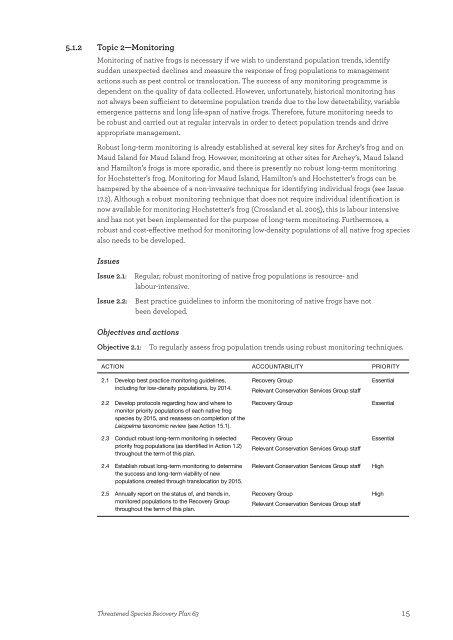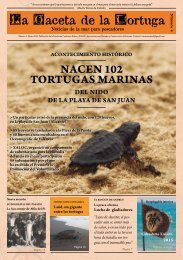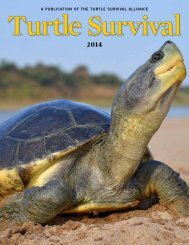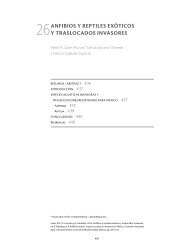tsrp63entire
tsrp63entire
tsrp63entire
You also want an ePaper? Increase the reach of your titles
YUMPU automatically turns print PDFs into web optimized ePapers that Google loves.
5.1.2 Topic 2—Monitoring<br />
Monitoring of native frogs is necessary if we wish to understand population trends, identify<br />
sudden unexpected declines and measure the response of frog populations to management<br />
actions such as pest control or translocation. The success of any monitoring programme is<br />
dependent on the quality of data collected. However, unfortunately, historical monitoring has<br />
not always been sufficient to determine population trends due to the low detectability, variable<br />
emergence patterns and long life-span of native frogs. Therefore, future monitoring needs to<br />
be robust and carried out at regular intervals in order to detect population trends and drive<br />
appropriate management.<br />
Robust long-term monitoring is already established at several key sites for Archey’s frog and on<br />
Maud Island for Maud Island frog. However, monitoring at other sites for Archey’s, Maud Island<br />
and Hamilton’s frogs is more sporadic, and there is presently no robust long-term monitoring<br />
for Hochstetter’s frog. Monitoring for Maud Island, Hamilton’s and Hochstetter’s frogs can be<br />
hampered by the absence of a non-invasive technique for identifying individual frogs (see Issue<br />
17.2). Although a robust monitoring technique that does not require individual identification is<br />
now available for monitoring Hochstetter’s frog (Crossland et al. 2005), this is labour intensive<br />
and has not yet been implemented for the purpose of long-term monitoring. Furthermore, a<br />
robust and cost-effective method for monitoring low-density populations of all native frog species<br />
also needs to be developed.<br />
Issues<br />
Issue 2.1:<br />
Issue 2.2:<br />
Regular, robust monitoring of native frog populations is resource- and<br />
labour-intensive.<br />
Best practice guidelines to inform the monitoring of native frogs have not<br />
been developed.<br />
Objectives and actions<br />
Objective 2.1:<br />
To regularly assess frog population trends using robust monitoring techniques.<br />
Action Accountability Priority<br />
2.1 Develop best practice monitoring guidelines,<br />
including for low-density populations, by 2014.<br />
2.2 Develop protocols regarding how and where to<br />
monitor priority populations of each native frog<br />
species by 2015, and reassess on completion of the<br />
Leiopelma taxonomic review (see Action 15.1).<br />
2.3 Conduct robust long-term monitoring in selected<br />
priority frog populations (as identified in Action 1.2)<br />
throughout the term of this plan.<br />
2.4 Establish robust long-term monitoring to determine<br />
the success and long-term viability of new<br />
populations created through translocation by 2015.<br />
2.5 Annually report on the status of, and trends in,<br />
monitored populations to the Recovery Group<br />
throughout the term of this plan.<br />
Recovery Group<br />
Relevant Conservation Services Group staff<br />
Recovery Group<br />
Recovery Group<br />
Relevant Conservation Services Group staff<br />
Relevant Conservation Services Group staff<br />
Recovery Group<br />
Relevant Conservation Services Group staff<br />
Essential<br />
Essential<br />
Essential<br />
High<br />
High<br />
Threatened Species Recovery Plan 63<br />
15





